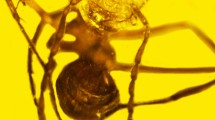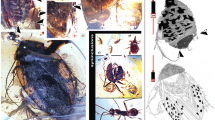Abstract
Ants are one of the most studied insects in the world; and the literature devoted to their origin and evolution, systematics, ecology, or interactions with plants, fungi and other organisms is prolific. However, no consensus yet exists on the age estimate of the first Formicidae or on the origin of their eusociality. We review the fossil and biogeographical record of all known Cretaceous ants. We discuss the possible origin of the Formicidae with emphasis on the most primitive subfamily Sphecomyrminae according to its distribution and the Early Cretaceous palaeogeography. And we review the evidence of true castes and eusociality of the early ants regarding their morphological features and their manner of preservation in amber. The mid-Cretaceous amber forest from south-western France where some of the oldest known ants lived, corresponded to a moist tropical forest close to the shore with a dominance of gymnosperm trees but where angiosperms (flowering plants) were already diversified. This palaeoenvironmental reconstruction supports an initial radiation of ants in forest ground litter coincident with the rise of angiosperms, as recently proposed as an ecological explanation for their origin and successful evolution.

Similar content being viewed by others
Explore related subjects
Discover the latest articles and news from researchers in related subjects, suggested using machine learning.References
Archibald SB, Cover SP, Moreau CS (2006) Bulldog ants of the Eocene Okanagan Highlands and history of the subfamily (Hymenoptera: Formicidae: Myrmeciinae). Ann Entomol Soc Am 99:487–523
Azar D (2000) Les ambres mésozoïques du Liban. Ph.D. dissertation, University Paris XI, Orsay, Paris, pp 1–164
Bolton B (1995) A taxonomic and zoogeographical census of the extant ant taxa (Hymenoptera: Formicidae). J Nat Hist 29:1037–1056
Bolton B (2003) Synopsis and classification of Formicidae. Mem Am Entomol Inst 71:1–370
Brady SG, Schultz TR, Fisher B, Ward PS (2006) Evaluating alternative hypotheses for the early evolution and diversification of ants. Proc Natl Acad Sci USA 103:18172–18177
Brandão CRF, Martins-Neto RG, Vulcano MA (1989) The earliest known fossil ant (first Southern Hemisphere Mesozoic record) (Hymenoptera, Formicidae, Myrmicinae). Psyche 96:195–208
Brothers DJ, Rasnitsyn AP (2003) Diversity of Hymenoptera and other insects in the Late Cretaceous (Turonian) deposits at Orapa, Botswana: a preliminary review. Afr Entomol 11:221–226
Crozier RH, Jermiin LS, Chiotis M (1997) Molecular evidence for a Jurassic origin of ants. Naturwissenschaften 84:22–23
Darling DC, Sharkey MJ (1990) Order Hymenoptera. In: Grimaldi DA (ed) Insects from the Santana Formation, Lower Cretaceous, of Brazil. Bull Am Mus Nat Hist 195:123–153
Delclòs X, Arillo A, Peñalver E, Barrón E, Soriano C, López Del Valle R, Bernárdez E, Corral C, Ortuño VM (2007) Fossiliferous amber deposits from the Cretaceous (Albian) of Spain. Comptes Rendus Palevol 6:135–149
Dlussky GM (1975) Superfamily Formicoidea Latreille, 1802. Family Formicidae Latreille, 1802. In: Rasnitsyn AP (ed) Hymenoptera Apocrita of the Mesozoic. Trans Paleontol Inst Acad Sci USSR 147:114–122 (in Russian)
Dlussky GM (1983) A new family of Upper Cretaceous Hymenoptera: an “intermediate link” between the ants and the scolioids. Paleontol Z 3:65–78 (in Russian, English translation in 1984, Paleontol J 17:63–76)
Dlussky GM (1987) New Formicoidea (Hymenoptera) of the Upper Cretaceous. Paleontol Z 1987(1):131–135 (in Russian, English translation in 1988, Palaeontol J 21:146–150)
Dlussky GM (1996) Ants (Hymenoptera: Formicidae) from Burmese amber. Paleontol J 30:449–454
Dlussky GM (1999) The first find of the Formicoidea (Hymenoptera) in the Lower Cretaceous of the Northern Hemisphere. Paleontolol J 33:274–277
Dlussky GM, Brothers DJ, Rasnitsyn AP (2004) The first Late Cretaceous ants (Hymenoptera: Formicidae) from southern Africa, with comments on the origin of the Myrmicinae. Insect Syst Evol 35:1–13
Emery C (1911) Hymenoptera fam. Formicidae subfam. Ponerinae. Genera Insectorum 118:1–125
Engel MS, Grimaldi DA (2005) Primitive new ants in Cretaceous amber from Myanmar, New Jersey, and Canada (Hymenoptera: Formicidae). Am Mus Novit 3485:1–23
Eskov KY (2002) Alphabetic list of selected insect fossil sites. 4.2. Fossil resins. In: Rasnitsyn AP, Quicke DLJ (eds) History of insects. Kluwer, Dordrecht, The Netherlands, pp 444–446
Gomez B, Daviero-Gomez V, Perrichot V, Thévenard F, Coiffard C, Philippe M, Néraudeau D (2004) Assemblages floristiques de l’Albien-Cénomanien de Charente-Maritime (SO France). Ann Paléontol 90:147–159
Grimaldi DA, Agosti D (2000) A formicine in New Jersey Cretaceous amber (Hymenoptera: Formicidae) and early evolution of the ants. Proc Natl Acad Sci USA 97:13678–13683
Grimaldi DA, Engel MS (2005) Evolution of the insects. Cambridge University Press, New York
Grimaldi DA, Agosti D, Carpenter JM (1997) New and rediscovered primitive ants (Hymenoptera: Formicidae) in Cretaceous amber from New Jersey, and their phylogenetics relationships. Am Mus Novit 3208:1–43
Grimaldi DA, Shedrinsky AM, Wampler TP (2000) A remarkable deposit of fossiliferous amber from the Upper Cretaceous (Turonian) of New Jersey. In: Grimaldi DA (ed) Studies on fossils in amber, with particular reference to the Cretaceous of New Jersey. Backhuys Publishers, Leiden, pp 1–76
Grimaldi DA, Engel MS, Nascimbene PC (2002) Fossiliferous Cretaceous amber from Myanmar (Burma): its rediscovery, biotic diversity, and paleontological significance. Am Mus Novit 3361:1–71
Hölldobler B, Wilson EO (1990) The ants. Harvard University Press, Cambridge
Jell PA, Duncan PM (1986) Invertebrates, mainly insects, from the freshwater, Lower Cretaceous, Koonwarra fossil bed, (Korumburra Group), South Gippsland, Victoria. In: Jell PW, Roberts J (eds) Plants and invertebrates from the Lower Cretaceous Koonwarra fossil bed, South Gippsland, Victoria. Mem Assoc Australas Palaeontol 3:111–205
Masse JP, Bellion Y, Benkhelil J, Dercourt J, Guiraud R, Ricou LE (1993) Lower Aptian (114–112 Ma). In: Dercourt J, Ricou LE, Vrielynck B (eds) Atlas Tethys, palaeoenvironmental maps. Gauthier-Villars, Paris, pp 135–152+1 map
Moreau CS, Bell CD, Vila R, Archibald SB, Pierce NE (2006) Phylogeny of the ants: diversification in the age of angiosperms. Science 312:101–104
Naumann ID (1993) The supposed Cretaceous ant Cretacoformica explicata Jell and Duncan. J Aust Entomol Soc 32:353–356
Nel A, Perrault G, Perrichot V, Néraudeau D (2004) The oldest ant in the Lower Cretaceous amber of Charente-Maritime (SW France) (Insecta: Hymenoptera: Formicidae). Geologica Acta 2:23–29
Pekár S, Král J (2002) Mimicry complex in two central European zodariid spiders (Araneae: Zodariidae): how Zodarion deceives ants. Biol J Linn Soc 75:517–532
Perrichot V (2004) Early Cretaceous amber from south-western France: insight into the Mesozoic litter fauna. Geologica Acta 2:9–22
Perrichot V (2005) Environnements paraliques à ambre et à végétaux du Crétacé nord-aquitain (Charentes, Sud-Ouest de la France). Mém Géosciences Rennes 118:1–310
Perrichot V, Nel A, Néraudeau D, Lacau S, Guyot T (2007a) New fossil ants in French Cretaceous amber (Hymenoptera: Formicidae). Naturwissenschaften DOI 10.1007/s00114-007-302-7
Perrichot V, Néraudeau D, Nel A, De Ploëg G (2007b) A reassessment of the Cretaceous amber deposits from France and their palaeontological significance. African Invertebrates 48:213–227
Pike EM (1994) Historical changes in insect community structure as indicated by hexapods of Upper Cretaceous Alberta (Grassy Lake) amber. Can Entomol 126:695–702
Poinar GO, Danforth BN (2006) A fossil bee from Early Cretaceous Burmese amber. Science 314:614
Poinar GO, Milki R (2001) Lebanese amber. The oldest ecosystem in fossilized resin. Oregon State University Press, Corvallis
Rasnitsyn AP, Martínez-Delclòs X (2000) Wasps (Insecta: Vespida = Hymenoptera) from the Early Cretaceous of Spain. Acta Geol Hisp 35:65–95
Rasnitsyn AP, Zherikhin VV (2002) Alphabetic list of selected insect fossil sites. 4.1. Impression fossils. In: Rasnitsyn AP, Quicke DLJ (eds) History of insects. Kluwer, Dordrecht, the Netherlands, pp 437–444
Rasnitsyn AP, Jarzembowski EA, Ross AJ (1998) Wasps (Insecta: Vespida = Hymenoptera) from the Purbeck and Wealden (Lower Cretaceous) of southern England and their biostratigraphical and palaeoenvironmental significance. Cretac Res 19:329–391
Scotese CR (2001) Atlas of earth history, vol 1. PALEOMAP Project, Arlington, Texas
Ward PS, Brady SG (2003) Phylogeny and biogeography of the ant subfamily Myrmeciinae (Hymenoptera: Formicidae). Invertebrate Systematics 17:361–386
Wilson EO (1985) Ants from the Cretaceous and Eocene amber of North America. Psyche 92:205–216
Wilson EO, Hölldobler B (2005a) The rise of the ants: a phylogenetic and ecological explanation. Proc Natl Acad Sci USA 102:7411–7414
Wilson EO, Hölldobler B (2005b) Eusociality: origin and consequences. Proc Natl Acad Sci USA 102:13367–13371
Wilson EO, Carpenter FM, Brown WL Jr (1967) The first Mesozoic ants, with the description of a new subfamily. Psyche 74:1–19
Zherikhin VV, Mostovski MB, Vršanský P, Blagoderov VA, Lukashevich ED (1999) The unique Lower Cretaceous locality Baissa and other contemporaneous fossil insect sites in North and West Transbaikalia. In: Vršanský P (ed.) Proceedings of the First Palaeoentomological Conference, Moscow, 1998. AMBA Projects, Bratislava, Slovakia, pp 185–191
Ziegler PA (1990) Geological atlas of western and central Europe, 2nd ed. Shell International Petroleum, Geological Society, London
Ziegler AM, Rowley DB (1998) The vanishing record of epeiric seas with emphasis on the Late Cretaceous “Hudson Seaway”. In: Crowley TJ, Burke K (eds) Tectonic boundary conditions for climate reconstructions. Oxford University Press, Oxford, pp 147–165
Acknowledgements
We thank Thierry Guyot and Eric Depré who gave some of the fossil ants discussed in this paper; Alain Canard (Univ. Rennes 1) for the preliminary comments on the zodariid fossil spiders; Carl Findley for checking the English; and the anonymous reviewers for the useful comments on the manuscript. This work was supported by the CNRS programme ECLIPSE II on “Cretaceous climates and ecosystems” and by Alexander von Humboldt Foundation for VP.
Author information
Authors and Affiliations
Corresponding author
Rights and permissions
About this article
Cite this article
Perrichot, V., Lacau, S., Néraudeau, D. et al. Fossil evidence for the early ant evolution. Naturwissenschaften 95, 85–90 (2008). https://doi.org/10.1007/s00114-007-0301-8
Received:
Revised:
Accepted:
Published:
Issue Date:
DOI: https://doi.org/10.1007/s00114-007-0301-8




